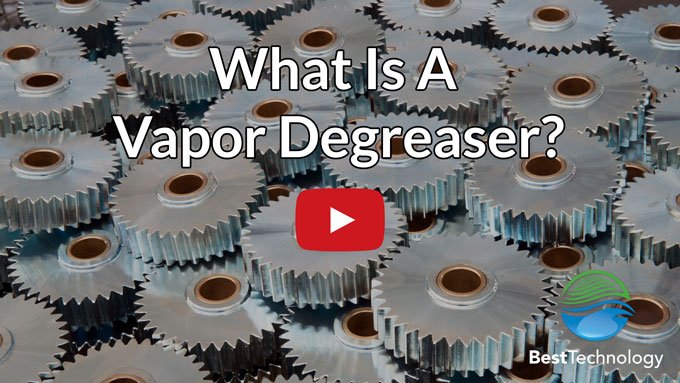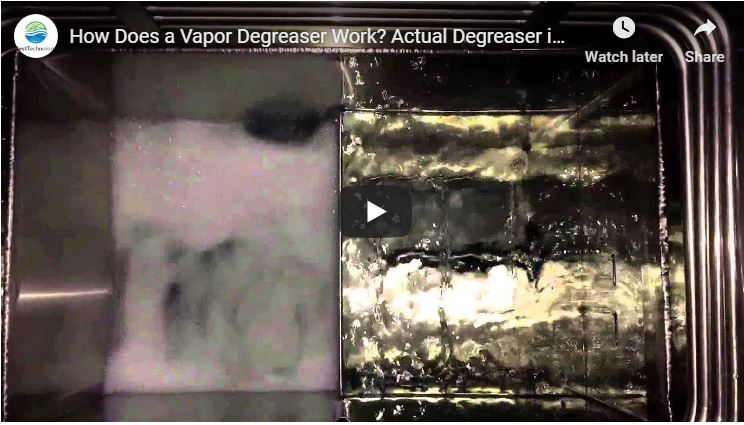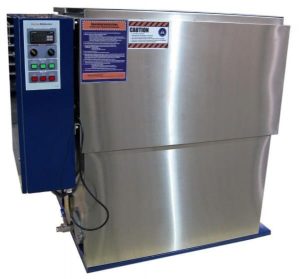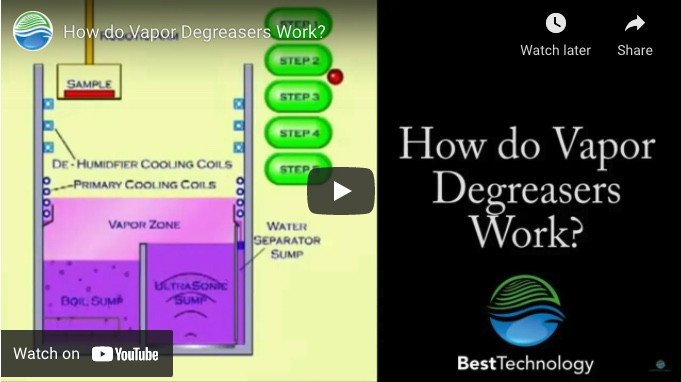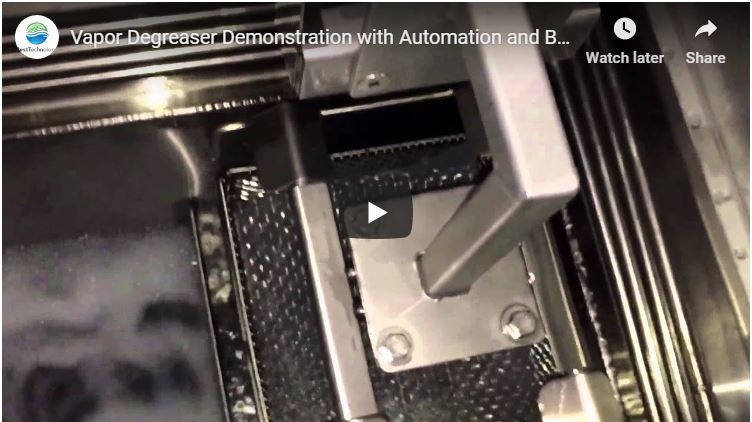What is Vapor Degreasing?
A vapor degreaser uses boiling solvent, rather than water, for fast precision cleaning and removal of true oils from parts. Vapor degreasing machines apply the principles of distillation and condensation to achieve high-quality cleaning and quick drying.
Vapor degreasers have been around for a long time, but that doesn’t mean they are all created equal. Best Technology offers the highest quality vapor degreasing equipment for sale in the industry. The significant advancements in cleaning solvent fluids have brought increased solvent costs; therefore, vapor degreaser solvent recapture and vapor degreasing distillation have never been more important. Ensuring the proper boiling heat capacity balanced with chilling capacity and freeboard is a must for today’s vapor degreasers. We are experienced in proper vapor degreaser equipment sizing and the latest vapor degreaser solvents used in them.
Video: What Is A Vapor Degreaser?
Ultrasonic Vapor Degreasing
Optionally, in some vapor degreaser machines, the parts may also be immersed into the solvent with ultrasonics in the rinse sump to “microscrub” the particulates off into the solvent. A vapor degreaser with this option is known as an ultrasonic vapor degreaser.
Video: Ultrasonic Vapor Degreaser in Operation
Vapor Degreaser – M Series
Floor-Standing Vapor Degreasers for Full-Scale Production
MEK, trichlor and nPb are great vapor degreasing solvents of the past that worked well but can no longer be used due to environmental impact and employee exposure limits. You can read more about phase-outs of past vapor degreaser solvents in our brief history of cleaning solvents. To learn more about vapor degreaser solvents, please see our Solvent Cleaning page.
How Do Vapor Degreasers Work?
The following video demonstrates the vapor degreasing process in an industrial degreaser machine.
Benchtop Vapor Degreasers for Smaller Applications
Inside the tank, liquid solvent is heated to a vapor which envelops the soiled part suspended in the vapor zone of the vapor degreaser. As the vaporized/boiled solvent condenses when the part at ambient temperature enters the vapor, dirt and contaminants are washed from the part and drained back into the liquid solvent solution in the boil sump of the vapor degreaser.
Vapor Degreasing FAQs
-
How does a vapor degreaser work?
If you’ve ever been wearing glasses as you walked into an air-conditioned building on a hot summer day, you already have a good understanding of part of how the vapor degreaser process works. (For those in colder climates, walking outside while wearing glasses on a cold winter day is an even better example.)
So, how does a vapor degreaser work? The vapor degreasing process is a cleaning process that uses solvent vapors (boiled solvent) rather than water to clean parts.
A vapor degreaser has two tanks (sumps) of solvent inside. One vapor degreasing tank boils the solvent (boil sump) which creates a vapor or mist of the solvent. The second sump (ultrasonic sump) is heated but not to the boiling point and is used as the second cleaning stage. The vapor degreaser also has bands of cooling coils inside just above the level of the sumps. These coils cause the vapor to return to a liquid state and fall back into the sump. The effect is like small “clouds” of the solvent are formed between the top of the sumps and the cooling tubes.
As parts at room temperature are lowered through the cooling area into the vapor, the vapor from the boil sump condenses on the parts just like moisture in the air does on your glasses in the examples above. This condensation contains the solvent that dissolves the oils on your parts, and the beading action creates droplets which run across the surfaces of the parts and fall back into the boil sump. The parts are then moved to the ultrasonic sump which contains heated but non-boiling solvent. This allows the parts to be lowered into the sump so that any blind holes or internal features are also thoroughly exposed to the solvent.
Finally parts are raised into the cooling coil area to allow the solvent to quickly dry and and then raised through a second layer of freeboard coils near the very top of the vapor degreaser that insure complete drying and the recapture of the solvent from the parts.
-
How do I convert my vapor degreaser to a new solvent?
As the clock runs out on the 3M™ Novec™ phaseout, many manufacturers are wondering how to switch their vapor degreasers to a 3M™ Novec™ replacement solvent such as BestSolv™ Engineered Fluids.
Here are the steps to use when converting your vapor degreaser to a new solvent.
Remove Old Solvent
Completely remove the old solvent from the vapor degreaser before adding the new solvent. Any residual old solvent left in the lines may be flushed with the new solvent. Do NOT use water to clean the vapor degreaser or flush the lines.
Add New Solvent
Review the Safety Data Sheet for the new solvent prior to first use. As always when handling solvents, use appropriate protective equipment as mentioned in the Safety Data Sheet. Since most solvents are designed to evaporate quickly, be careful not to leave the solvent container open any longer than necessary.
Identify Boiling Point of New Solvent
The boiling point on your new solvent may be different from that of the old solvent. Vapor degreaser settings are based on the boiling point of the solvent used, and should be adjusted when a new solvent is used in the degreaser.
Use the Safety Data Sheet, Technical Data Sheet, or other publicly available source to identify the boiling point of the new solvent. For BestSolv™ Engineered Fluids, you can find this information through our Technical Data Sheets page.
Adjust Vapor Degreaser Settings
Use the new solvent’s boiling point as a reference for changing the following settings on your vapor degreaser:
Vapor Degreaser Setting Set Point Liquid Temperature Control (LTC) Boiling Point plus 7-10 °F High Temperature Control (HTC) Boiling Point plus 10-15 °F Solvent Vapor Control (SVC) Boiling Point minus 10 °F Vapor Up Control (TH-1) Boiling Point minus 10 °F For example, a solvent with a boiling point of 165 °F would have a Vapor Up Control (TH-1) set point of 155 °F (165 – 10 = 155).
That’s it! Your vapor degreaser is ready to return to precision cleaning with your new solvent.
NOTE: Vapor degreaser controls differ by manufacturer. Some may not contain all of the settings described.
For further information about vapor degreaser settings, see the reference section below.
Vapor Degreaser Settings Reference
- Liquid Temperature Control (LTC): Set 7-10 °F above the boiling point of the solvent being used. A 10 °F rise in the boiling point indicates that the boiling sump has accumulated the equivalent oil solution of approximately 30% by weight, along with any other contaminants. Boil down and addition of fresh solvent is recommended.
- High Temperature Control (HTC): Set 10-15 °F above the boiling point of the solvent being used. A 10 °F rise in the boiling point indicates that the boiling sump has accumulated the equivalent oil solution of approximately 30% by weight, along with any other contaminants. Continued operation may be hazardous.
- Low Level Control (LLC): A safety to turn the heat off if the liquid level falls below a safe level.
- Refrigeration Control (RT): Regulates the temperature of the cooling coils. Typically set at 45-50 °F. It is not necessary to change this setting when changing solvents.
- Solvent Vapor Control (SVC): Turns off the heat in the event of high vapor level and must be set at 10 °F below the boiling point of the solvent being used.
- Vapor Up Control (TH-1): Turns on an indicator light when the solvent vapors are up to proper level on the cooling coils. This indicates the equipment is ready to operate. It also inhibits the spray pump(s) when the vapor line is below the normal operating level. The proper temperature setting is 10 °F below the boiling point of the solvent being used.
-
Is desiccant required in a vapor degreaser?
Desiccants are used to absorb the water found in humid conditions to reduce or eliminate condensation. It can also be added directly to liquids to absorb the water content from the fluid. We are used to seeing the small white bags of desiccant found in packaging for everything from shoes to electronic equipment. Most of this desiccant is silica – typically in gel form. Other common substances used as desiccants are activated charcoal and calcium chloride.
The desiccant used in vapor degreasers is 3 Angstrom Molecular Sieve, small pellets of zeolite clay. Like all desiccants, the zeolite clay adsorbs water from the solvent, and may be reused by baking it dry. Desiccants are most often used in a vapor degreaser if the solvent contains an alcohol. This is often the case with solvents used for defluxing processes on soldered boards and leads. Water found in the separator extracts the alcohol from the solvent and in turn the water and alcohol are absorbed by the zeolite clay. If a degreaser is operated in a very humid environment, a desiccant may be needed to effectively remove the water from the solvent.
Video: Automated Ultrasonic Vapor Degreasing Demonstration
Industry Applications for Vapor Degreasing Equipment
- Precision cleaning medical device parts where it’s critical that no chemical residue is left on parts
- Manufacturing processes requiring precision cleaning of true oils and particulates and quick drying
- Semiconductor printed circuit board cleaning and flux removal
- Aerospace parts cleaning for components required to conform to specifications such as AMS 1526 and BAC 5750
- Minimizing loss of vapor degreasing solvents
Solvent Cleaning FAQs
- Why use cleaning solvents?
- What are PFAS chemicals?
- 3M™ Novec™ phase out
- nPB phase out
- TCE phase out
- Methylene chloride phase out
Vapor Degreaser Solvents
Best Technology offers a wide variety of vapor degreaser solvents for use with your vapor degreaser equipment. We recommend BestSolv™ for your vapor degreaser solvent needs.
Common Configurations for Industrial Degreaser Machines
Our vapor degreasers come in a variety of configurations depending on customer application. We can size an industrial degreasing machine to fit not only your parts, but also your cycle time and production requirements. With today’s solvents it is essential to size the vapor degreaser properly to ensure maximum solvent recapture through distillation cycle chilling coils.
For expert help with your precision cleaning applications, look to Best Technology. Let us help you find the best vapor degreaser machine for sale that not only fits your parts, but also your cycle time and production requirements. Contact a vapor degreasing expert today to receive a free proposal.

